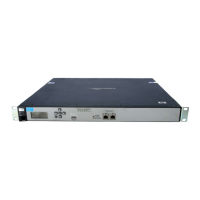Wireless configuration
Radio configuration
4-30
HP APs support the following two explicit beamforming techniques:
Non-compressed beamforming, in which the client station calculates and sends the
steering matrix to the AP.
Compressed beamforming, in which the client station sends a compressed steering
matrix to the AP.
Radio calibration is not required to use either of these two methods.
Note Beamforming only works with wireless clients that are configured to support it.
RTS threshold
Not available in Monitor or Sensor modes.
Use this parameter to control collisions on the link that can reduce throughput. If the
Controlled APs > [group] > [AP] >> Status > Wireless page shows increasing values for
Tx multiple retry frames or Tx single retry frames, adjust this value until the errors
clear. Start with a value of 1024 and decrease to 512 until errors are reduced or eliminated.
Note that using a small value for RTS threshold can affect throughput. Range: 128 to 1540.
If a packet is larger than the threshold, the AP holds the packet and issues a request to send
(RTS) message to the client station. The AP sends the packet only when the client station
replies with a clear to send (CTS) message. Packets smaller than the threshold are
transmitted without this handshake.
Spectralink VIEW
Supported on: MSMS310, MSM320, MSM335, MSM410, MSM422
Not available in Monitor or Sensor modes.
Provides support for Spectralink phones using Spectralink Voice Interoperability for
Enterprise Wireless (VIEW) extensions.
Tx protection
Supported on: E-MSM430, E-MSM460, E-MSM466
Not available in Monitor or Sensor modes.
When an AP is operating in an 802.11n mode, and legacy (a/b/g) traffic is present on the same
channel as 802.11n traffic, this feature can be used to ensure maximum 802.11n throughput.
The following options are available:
CTS-to-self: 802.11n transmissions are protected by sending a Clear To Send (CTS)
frame that blocks other wireless clients from accessing the wireless network.
RTS/CTS: 802.11n transmissions are protected by sending a Request To Send (RTS)
frame followed by a CTS frame. This is a more robust, but slower, solution than CTS-
to-self. However, this method resolves the hidden station problem (where certain
legacy stations may not see only a CTS frame).

